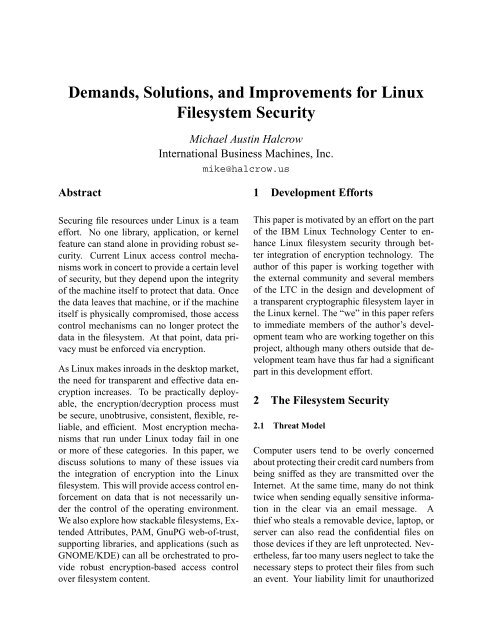You also want an ePaper? Increase the reach of your titles
YUMPU automatically turns print PDFs into web optimized ePapers that Google loves.
Demands, Solutions, and Improvements for <strong>Linux</strong><br />
Filesystem Security<br />
Michael Austin Halcrow<br />
International Business Machines, Inc.<br />
mike@halcrow.us<br />
Abstract<br />
Securing file resources under <strong>Linux</strong> is a team<br />
effort. No one library, application, or kernel<br />
feature can stand alone in providing robust security.<br />
Current <strong>Linux</strong> access control mechanisms<br />
work in concert to provide a certain level<br />
of security, but they depend upon the integrity<br />
of the machine itself to protect that data. Once<br />
the data leaves that machine, or if the machine<br />
itself is physically compromised, those access<br />
control mechanisms can no longer protect the<br />
data in the filesystem. At that point, data privacy<br />
must be enforced via encryption.<br />
As <strong>Linux</strong> makes inroads in the desktop market,<br />
the need for transparent and effective data encryption<br />
increases. To be practically deployable,<br />
the encryption/decryption process must<br />
be secure, unobtrusive, consistent, flexible, reliable,<br />
and efficient. Most encryption mechanisms<br />
that run under <strong>Linux</strong> today fail in one<br />
or more of these categories. In this paper, we<br />
discuss solutions to many of these issues via<br />
the integration of encryption into the <strong>Linux</strong><br />
filesystem. This will provide access control enforcement<br />
on data that is not necessarily under<br />
the control of the operating environment.<br />
We also explore how stackable filesystems, Extended<br />
Attributes, PAM, GnuPG web-of-trust,<br />
supporting libraries, and applications (such as<br />
GNOME/KDE) can all be orchestrated to provide<br />
robust encryption-based access control<br />
over filesystem content.<br />
1 Development Efforts<br />
This paper is motivated by an effort on the part<br />
of the IBM <strong>Linux</strong> Technology Center to enhance<br />
<strong>Linux</strong> filesystem security through better<br />
integration of encryption technology. <strong>The</strong><br />
author of this paper is working together with<br />
the external community and several members<br />
of the LTC in the design and development of<br />
a transparent cryptographic filesystem layer in<br />
the <strong>Linux</strong> kernel. <strong>The</strong> “we” in this paper refers<br />
to immediate members of the author’s development<br />
team who are working together on this<br />
project, although many others outside that development<br />
team have thus far had a significant<br />
part in this development effort.<br />
2 <strong>The</strong> Filesystem Security<br />
2.1 Threat Model<br />
Computer users tend to be overly concerned<br />
about protecting their credit card numbers from<br />
being sniffed as they are transmitted over the<br />
Internet. At the same time, many do not think<br />
twice when sending equally sensitive information<br />
in the clear via an email message. A<br />
thief who steals a removable device, laptop, or<br />
server can also read the confidential files on<br />
those devices if they are left unprotected. Nevertheless,<br />
far too many users neglect to take the<br />
necessary steps to protect their files from such<br />
an event. Your liability limit for unauthorized

















